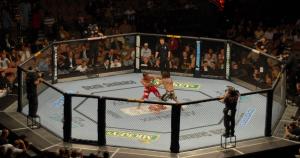We’re a tribal species.
Our way is THE way. To break from (or even doubt) our most cherished views and traditions is heresy. Depending on the particular tribe, you risk insult, financial livelihood, relationships, and even death.
Most political and religious camps certainly follow this trend. You’re either all in or risk it all. Shun, cancel, and eliminate threats; heresy will not be tolerated.
Given our evolutionary history, tribalism is not a surprise. But what are the odds that the Venn Diagram of truth perfectly intersects with all of the tribe’s orthodoxies? With polarization and censorship steadily increasing, are we moving forward or de-evolving?
Has social media made us apes again?
In this current landscape, a “battleground of ideas” sounds harsh, combative, and risky. And for the aforementioned reasons, unfortunately it is. Never in my lifetime have I seen such polarization and tribalism. And the cure (free speech, critical inquiry, and a friendly exchange of ideas where “the other” is not demonized) is on short supply and waning.
But for truth-seeker, a “battleground of ideas” is not danger – it’s therapy. To get closer to truth is to abandon bad ideas and positively evolve one’s thinking – and ultimately their character. Knowledge, as they say, is power. A glimmer of hope of this model is offered in perhaps a counterintuitive place: mixed martial arts. Judo, Karate, Tae Kwon Do, wrestling, boxing, kickboxing, Brazilian Jiu-Jitsu, and many other traditions were taught historically from their respective vantage point. Their singular art/tradition was the best. Many still hold this position.
Bruce Lee, a brilliant philosopher and martial artist, tried to free us from this myopic thinking. He created Jeet Kune Do to be a style without a style, an art that that incorporates all arts – using whatever works from all traditions – at the right moment in a specific situation. And so goes the classical definition of knowledge in philosophy: “justified true belief”. Lee’s genius was applying this to martial arts; epistemology (study of knowledge) an ideological evolution – ideas standing on their own merits. Through the crucible of mutation and natural selection, a hybrid mechanism evolves – truth is found only through justifying what works by the clashing of ideas/traditions – not clinging to one tradition as truth. So too it goes with one’s thinking and character. Had he seen the state of current MMA, he would smile.
I’ll go further, if he came back from the dead today, most elite MMA fighters in his weight class would soundly defeat him in the octagon – a compliment to his theory.
Though Bruce Lee was a great popularizer of martial arts (and many credit as a key figure in the birth of mixed martial arts for this reason), the birth of mixed martial arts centers around Vale Tudo matches with no (or very limited) rules. These matches inherently became a way to put various traditions to the test. Helio Gracie, who modified Japanese Jiu-Jitsu into Brazilian Jiu-Jitsu, and the Gracie family after him catapulted a dramatic evolution. Confidence in their own art in Vale Tudo matches against all types of styles empirically proved that not having any knowledge of Brazilian Jiu-Jitsu – against a skilled BJJ practitioner – is like fighting a crocodile in the water.
Today, the symbol of of the octagon – and the explosive growth and evolution that the UFC has fueled stands for something larger.
 The octagon has become epistemological crucible where ideas can be tested – and through mutation and natural selection – martial arts as a whole has evolved.
The octagon has become epistemological crucible where ideas can be tested – and through mutation and natural selection – martial arts as a whole has evolved.
Since the first UFC, you saw all the traditional arts clash on camera – and Brazilian Jiu-Jitsu came out on top. 180 pound Royce Gracie submitted the much larger 220 pound Ken Shamrock in 57 seconds. He went on to win UFC 1, 2, and 4 against much larger opponents in many of the fights.
Besides this event catalyzing the explosive growth of Brazilian Jiu-Jitsu, something else amazing changed. The “my art is the best” was no longer a theological/philosophical proposition, but an empirical one that was now being regularly tested. And from then on, all would have to develop a grappling game to be a competitive MMA fighter.
But it wasn’t just Brazilian Jiu-Jitsu. Grappling experts and “traditional strikers” (boxing, karate, kung fu, kickboxing, etc.) also came face to face with Muay Thai fighters that would throw low leg and calf kicks. For those that didn’t have the ability to block (or “check”) those kicks, their legs would literally get ripped apart and they’d be limping into the later rounds – or the ref would stop the fight as they eventually couldn’t stand.
Without a ground game, boxing pedigree, or low kick checking game, you’ll have a very tough time being successful in MMA. From this evolution we’ve seen the clash of ideas get us closer to truth. Clinging to one tradition or point of view is to inherently be self-limited. A boxer with no ground game or a grappler with no striking game would both be in very real danger with an accomplished MMA fighter that has all the tools at their disposal.
And so mixed martial arts is truly philosophy in motion – an epistemological octagon where ideas and traditions are tested philosophically and scientifically – and MMA itself continues to evolve in real time. The octagon has taught us to let strong ideas stand on their own merits and weak ideas die off. Shake hands after and learn something. Evolve and repeat. We’ll all get better – our collective thought is strengthened. Our character is not shaped by our ideas, but how we come them. We progress in testing our ideas to find out what is true, for this is the path of true knowledge.
Perhaps no better stated than Bruce Lee, “absorb what is useful, discard what is useless and add what is specifically your own”.
Image credit: Lee Brimelow

















